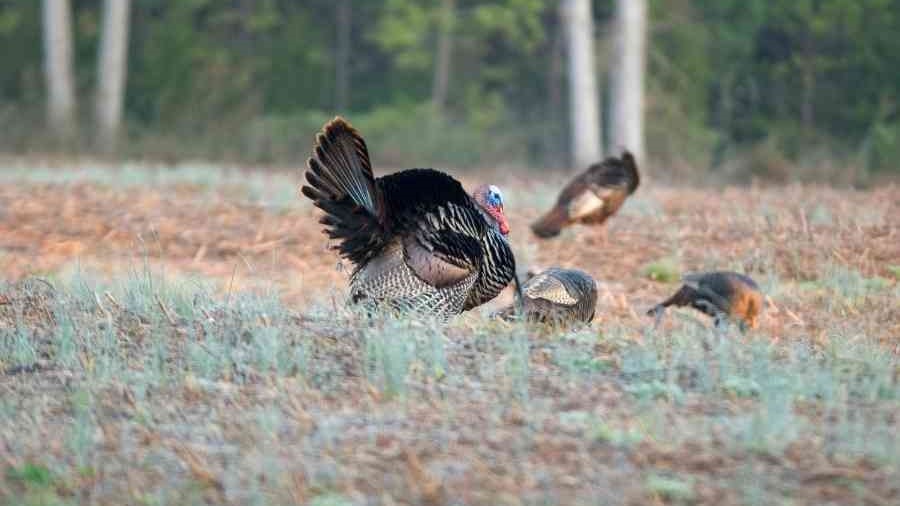Turkeys are highly vocal by nature, and if you intend to fill your tags, you must know how to speak the language. This is done with the use of a quality turkey call. With the right turkey call in hand, you can coax gobblers from great distances, bringing them into bow range. This leads to an endless number of hunters every spring seeking out the calls for taking tough toms.



A Call That Talks The Talk
When selecting turkey calls, it is important to only select a call that is at least somewhat versatile in the range of vocalizations that it can replicate. Every turkey hunt is different, and no two hunts will present identical calling situations. Owning a versatile call prevents you from switching calls frequently whenever the situation at hand changes course.
At a Glance: Here are my Top Picks for Turkey Calls
+ BEST OVERALL – Lynch World Champion Turkey Box Call. This is my personal box call of choice. I have owned this call for approximately ten years, and it has served me well throughout.
___________________
+ SIMPLEST TO USE MOUTH CALL – Primos. I own a pair of those myself. The Hook Hunter is a call that can cover a wide range of calling needs in the spring turkey woods and can be used by anyone from beginners to old pros.
___________________
+ MOST VERSATILE – Preston Pittman. You can use this call to replicate a wide range of turkey vocalizations, all of which drive gobblers wild.
___________________
+ BEST FOR BEGINNERS – Knight & Hale. Push the peg end of the call forward, and it retracts on its own, producing perfect hen turkey sounds every time.
___________________
+ BEST FOR LONG DISTANCE – Woodhaven. Traditional Turkey Call. Hard-biting 2-note yelps and cutts are remarkable on this call.
Contents (Jump to Topic)
Toggle1. Lynch World Champion Turkey Box Call
Lynch World Champion Box Call – My favorite Box Call
Note: This is my personal box call of choice. I have owned this call for approximately ten years, and it has served me well throughout. Turkeys readily respond to the vocalizations that can be replicated with this call. Before its purchase, I was not much of a box call fan. However, the Lynch World Champion Turkey Box Call has made me a believer.
Pros:
- Extensive range
- Ease of use
- Ability to be used as a locator
Cons:
- Poor ability in wet weather
- Difficult to control volume
For many hunters, the box call serves as the gold standard for what a turkey can, and should be. This type of call has been around for decades and is characterized as a long hollow box, on which a flat, paddle-shaped lid pivots.
As this lid is manipulated by a hunter, it pivots back and forth, creating friction with the box’s lip. This friction produces high-pitched, Turkey-like noises.
Most box calls can be heard from long distances and make wonderful locator calls. In fact, box calls have gained quite the reputation for being capable of eliciting a gobble from tight-lipped toms, when nothing else will.
Box calls also replicate a wide range of turkey vocalizations, including yelps, purrs, cutts, and clucks.
Box calls are also straightforward and easy to master. Most hunters can become proficient enough in their use to call in a turkey, with little more than a single afternoon’s worth of practice.
Mastery of the box call can be obtained throughout a single season if one puts in their fair share of practice.
However, it is worth considering, that it can often be difficult to meter a box call’s volume. This can become a concern when you are attempting to work turkeys at close range, where extensively loud calling can push a bird in the opposite direction.
Wet and extremely humid weather can also have temporary, yet detrimental effects on a box call’s ability to perform, due to a loss of friction.
2. Primos Mouth Call Turkey Diaphragm Calls
Primos Mouth Call – I own those myself
Note: This is my personal mouth call of choice. You can use this call to replicate a wide range of turkey vocalizations, all of which drive gobblers wild. This call is also durable, as I have only managed to go through two of them in the last 8 years. I lost the first of the two and had I not, it would likely still be accompanying me to the woods.
Pros:
- Can replicate any turkey sound
- Operable in a hands-free fashion
- Easy to meter volume
Cons:
- Difficult to learn
- Requires movement for use
Though diaphragm calls have been around for quite some time, they have grown enormously in popularity over the last couple of decades and become an undeniable staple of turkey hunting.
Diaphragm calls consist of a horseshoe-shaped frame, with a set of latex reeds stretched across its opening. The call’s frame is concealed within a sheath of tape.
A diaphragm call’s reeds typically feature subtle cuts, which produce variances in its sound characteristics. This style of call is placed between a hunter’s tongue, and the roof of their mouth, where air is forced across its reeds (read.. what do you call a group of turkeys).
This air causes a diaphragm call’s reeds to rapidly vibrate, producing high-pitched sounds, much like those emitted by a turkey.
Much of the diaphragm call’s popularity stems from its ability to be operated in a hands-free manner. This is of immense value, as a turkey can pick up on a hunter’s slightest movements, especially at close distances.
Additionally, diaphragm calls are unaffected by the weather, allowing them to be used universally, no matter the conditions that one faces.
Diaphragm calls can be rather difficult to master, often taking years.
However, those who are new to mouth call use can typically learn to produce basic sounds, such as yelps and clucks, in a matter of 2-3 months’ worth of practice.
Despite requiring patience to learn, the use of a mouth call is well worth the effort expended on a hunter’s behalf, as a quality mouth call is capable of producing any turkey vocalization imaginable.
3. Preston Pittmann “Black Diamond”
Preston Pittman “The Black Diamond” Diaphragm
Pros:
- Great tones
- Diamond Cut
- Thin Reeds
Cons:
- Learning Curve involved
The Preston Pittman Turkey Call is another Diaphragm call that is great for beginners. This call is very versatile and can be used for many different types of turkey hunting situations.
Note: Perfect for beginners and seasoned veterans who know not to call every bird loudly. It has great tones and ultra-thin reeds.
4. Primos Rare Breed Glass Turkey Pot Call
Primos Rare Breed – Glass Turkey Pott Call
Pros:
- Highly versatile
- Easy to control volume
- Relatively simple to use
Cons:
- Poor ability in wet weather
- Requires extensive movement for use
A pot or “slate” call, as it is referred to by many, is another type of turkey call which dates back a number of decades.
This call utilizes an up-facing circular pot with a flat bottom, that contains a piece of slate, glass, crystal, or aluminum inside its face.
A striker, most commonly made of wood or carbon, is drug across this face material, to create friction.
This friction, when strategically initiated, is capable of reproducing virtually any turkey vocalization imaginable. The range of a pot call can vary significantly depending upon its material composition.
However, most can be easily controlled in a way that makes it possible to call with extreme volume, or at a very subtle pitch.
Pot calls tend to be somewhat more difficult to master than a box call, though a hunter can become proficient in their use within a short period of time with a little practice.
Most hunters begin learning to use a pot call by producing a standard yelp. One can then shorten these notes and vary their calling cadence in order to produce cluck, cutts, and purrs.
The effectiveness of a pot call can be hindered by wet and rainy weather (read.. Turkey Hunting in the Rain), as this reduces the call’s ability to produce friction.
However, numerous calls of this variety have been engineered from alternative materials in recent years, which are largely impervious to the effects of moisture.
This has made pot call use far more viable when hunting in all but the heaviest of downpours.
Note: Extremely realistic-sounding turkey calls often give you the slight edge that you need to scratch out a hard-fought victory against a wary tom. When hunting hard-pressured gobblers, a hunter needs all the help they can get.
5. Turkey Tube Calls
Primos Hunting – Tube Call
Pros:
- Unparalleled range
- Excellent volume control
- Robust sound quality
Cons:
- Difficult to learn
- Failure of the diaphragm or connecting band can occur
Tube calls, while not as popular as they were in years past, are still a highly effective tool in any turkey hunter’s arsenal.
A tube call is characterized as a short hollow tube, often no longer than 3-4 inches in length, with a latex reed stretched across a portion of the tube’s opening at one end.
A hunter blows air across the call’s latex reed, creating a sound that is then amplified through the tube.
A tube call is renowned as an excellent locator call, as it can often be heard from a mile or more when operated by an experienced hunter.
This can be extremely beneficial when hunting expansive river bottoms, or large tracts of public land, where birds can roost almost anywhere.
On the opposite end of the spectrum, tube calls can also be blown extremely quietly when the need arises.
Many hunters also favor tube calls for their waterproof functionality. Much like a diaphragm call, tube calls operate upon the vibration of a reed, as opposed to friction.
With no friction required for proper use, a hunter can confidently pack a tube call along on every hunt, without any care as to what the weather forecast looks like.
Note: It is worth mentioning, however, that tube calls can be relatively difficult to get the hang of. While passable turkey sounds can be produced on a tube call with minimal practice, true mastery often takes years.
In time, the use of a tube call begins to become instinctual in a way, much like riding a bike.
7. Turkey Trumpet Call
Primos Wingbone Trumpet Call
Pros:
- Ultra-realistic sound quality
- Unmatched volume control
- Impervious to weather
Cons:
- Extremely difficult to use
- Often expensive to purchase
A trumpet is perhaps the most realistic sounding of all turkey calls, yet among the most difficult to use as well.
This call consists of a hollow, pencil-like tube, which is bell-shaped at one end. On the opposite end of this bell, sits a narrow taper, fitted with a cork mouthpiece.
This tapered end of the trumpet call is placed to a hunter’s lips, where a kissing action takes place.
As a result, air is taken in through a trumpet call in small bursts. This passage of air creates sounds as it passes through a hunter’s lips and is amplified throughout the call’s body.
The trumpet call is capable of producing some of the richest-sounding yelps, cutts, and clucks imaginable, and is even preferred over various alternative call types by many veteran hunters.
The realistic tone produced by a trumpet call is often cited as being able to conjure a response from reluctant gobblers when nothing else will.
This tends to be especially true when hunting heavily pressured public lands, where turkeys are regularly bombarded by sounds from nearly every type of call imaginable.
Note: Because of their unconventional manner of use, in relation to various other types of turkey calls, trumpets are inherently difficult to use. In some cases, it can even take years for a hunter to become proficient enough in the use of a trumpet call, to make plausible-sounding vocalizations. Some, however, are never able to master the trumpet call, despite extensive effort.
8. Tom Gaskins Turkey Scratch Box
Tom Gaskins – Hand-Tuned Box Call
Pros:
- Great range
- Putts, Purrs, and Yelps
- Crisp tonal characteristics
- Easy to use
Cons:
- Requires hand movement for operation
- A heavy morning dew is often enough to render the scratch box inoperable, and rainfall makes the use of this call impossible.
In the past, the scratch box used to be as prominent as the box or pot call is today.
This unique little call employs the use of a small, rectangular piece of wood, along with a thinner piece of wood known as a scratcher, to create noise-producing friction.
The scratch box’s body is hollow in design and amplifies the call’s sound output, which is produced when each of the unit’s two pieces is rubbed together.
In many ways, the scratch box is somewhat of a hybrid between the box call and pot call.
A scratch box looks and operates much like a miniature box call, yet features a secondary friction device (scratcher), that can be interchanged to create different sounds, much like a pot call’s striker.
Scratch boxes are also very easy to operate, making them ideal for use by novice callers. Much like in the case of a box call, one can become proficient enough in the use of a scratch box to replicate basic turkey vocalizations in little more than a single afternoon.
Mastery of the scratch box can be achieved in a single season if one were to practice extensively.
Much of the scratch box’s fall from prominence has come at the hands of its sensitivity to moisture.
Note: If you intend to use a scratch box on an exclusive basis, it is advisable to hunt from an enclosed ground blind.
9. Hunters Specialties H.S. Strut Push Button Call
Hunters Specialities – Push Button Call
Pros:
- Simple to use
- Requires minimal movement
- Can produce a wide array of vocalizations
Cons:
- Limited in volume
- Not as vibrant in tone
A push-button call is an ideal choice for any novice caller, or youth hunter, as it is nearly impossible to use incorrectly.
This call consists of a rectangle box, which is open on one side. Inside this box sits a wooden dowel that protrudes outward, as well as a pronounced friction surface on which this dowel rides.
A hunter pushes on the dowl’s protruding end, which causes it to scrub across the adjoining friction block’s surface, emitting noise in the process.
A return spring then brings the dowl back to its neutral position when not acted upon by force. A push-button call is capable of producing yelps, clucks, cutts, and purrs, all with minimal input on a hunter’s behalf.
The push-button call has maintained significant popularity, primarily as a result of its ease of use.
This call can be operated in a simple enough fashion, that it is virtually impossible to produce a sound that is not turkey-like in nature.
Note: Many experienced hunters even keep a push-button call around, due to its ability to be operated without much in the way of visible movement.
Why Are Turkey Calls Important?
The use of a call makes it possible for a hunter to attract wary birds, that would otherwise be nearly impossible to get within range of. A turkey’s response to a hunter’s calling is largely instinctive in nature.
Turkeys are highly social animals and communicate with the use of numerous vocalizations. As a result, hunters use various calls to replicate these vocalizations.
During the spring of the year, toms are heavily focused on mating and are therefore extremely receptive to the vocalizations of hens.
Such vocalizations include yelps, cluck, cutts, and purrs, all of which convey a particular message on a hen’s behalf.
These subtle sounds are often met by an intrigued or excited response by any Tom within earshot. Turkey hunters use this knowledge to their advantage, in order to fool a tom into believing that a receptive hen awaits him over the next rise.
Turkey calls come in many different forms, each coming with its own set of advantages and disadvantages. While one type of call might yield success one day, an alternative type could very well be the winning choice during a hunter’s very next outing.
A Full Bag Of Tricks
While many hunters tend to cling to the use of their favorite call, doing so can actually be detrimental to their success. While a particular call might bring gobblers in at a dead run on one occasion, it might be incapable of rendering so much as a gobble during the following day’s hunt.
Turkeys tend to be ever-changing in their temperament and can be fickle in their preferences.
For this reason, it is important to always have more than one type of turkey call at your disposal during any trip to the woods. If at first, your calling falls on deaf ears, continue to try every turkey call in your vest, one by one, with a few minutes, break separating each effort.
Which Is The Best Turkey Call?
When comparing the turkey calls on this list, I feel that the Lynch World Champion Turkey Box Call is the best call, with the Preston Pittman Diamond Cut Mouth Call coming in as a not-so-distant runner-up.
I personally use the Lynch World Champion Turkey Box Call and the Primos Mouth Call – I had excellent results while turkey hunting myself. That´s why I can strongly recommend those two out of my personal experience. They are durable, and they get the job done.
Lynch World Champion Box Call – My favorite Box Call
The Lynch World Champion Turkey Box Call offers hunters the versatility to replicate any means of both hen and tom turkey vocalizations, is simple enough to be used by even novice callers, and produces a sound that you would have to hear to truly appreciate.
This is a call that any turkey hunter would be more than proud to carry in their turkey vest this spring.
The History and Evolution of Turkey Calls
Native Americans were using turkey calls as early as at least 4000 years ago. There is some controversy evolving around what exactly they were using. Read.. turkey broadheads.
They most likely used callers made out of the actual bones of a turkey. The wing bone to be precise. That’s how those calls came to their name: Wingbone Turkey Caller.
Want to make a traditional Turkey Call yourself (Watch Video)
You need:
- first three bones from a turkey wing (wild tom, jake or adult hen)
- Ultra Glue
- Thread
- Dremel / Hacksaw
- Knife and sandpaper
And here is the video:
With a vest full of calls, and the knowledge to use each wisely, a hunter is poised to experience a season like none other. With a little luck, a tom will be fooled into thinking that a hen awaits him just out of sight, much to the excitement of a camo-clad hunter behind the call.
FAQ
What is the easiest turkey call to use?
Turkey hunting calls like this one are very basic – but if you can yelp, you may be able to call in a turkey.
Can you overcall a turkey?
How long should you wait between Turkey calls?
Will turkeys call in the rain?
Will a slate call work in the rain?
What is the easiest diaphragm turkey call to use?
What are the best diaphragm turkey calls?
Which side of a turkey mouth call goes up?
Also, there is a bump on the frame. The side with the bump faces down. You’ll notice if it’s upside down. You will hear…















Conversation | 1 comment:
I just added that wing bone call to my list of things to do …